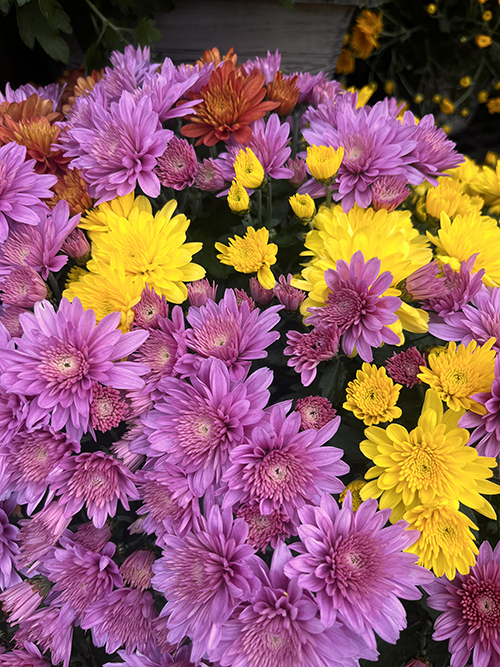Let It Grow
By Tammy Thornton
When it comes to fall decorating, mums are the perfect starting point. They are the quintessential fall flower and come in such a large variety of colors that you are sure to find the right ones to suit your taste. Normally, for maximum impact, it is best to use swathes of one color of various flowers in the garden for effect. But this time of year, a mixture of all the fall colors that mums have to offer makes a pleasing palette.
You may have also noticed a newcomer to the fall flower selection at your local nursery. Marigolds, normally sold in the spring, have hit the garden runways as the latest in fall fashion. Their various shades of frilly orange and burgundy petals make them the perfect accompaniment to mums. However, the two flowers come from different sides of the gardening block. Though often treated as annuals, mums (chrysanthemums) are perennials that will come back year after year if cared for properly. Marigolds, on the other hand, are annuals that must be replanted each year.
To keep your mums happy and healthy, make sure they are well-watered. Otherwise, they will turn brown and shrivel up well before trick-or-treaters show up at your door. The best way to preserve your mums would be to plant them directly in the ground. This way, they will have time to establish their roots before winter cold sets in. Once it freezes outside, the top portion of your mums will turn brown. But if you have been keeping them watered in well-drained soil throughout the fall, your mums will have healthy roots underground. In the spring, you will see new green growth at the base of the plant. This will be the time to prune away the dried-out stems. Though mums are fairly easy to care for, another way to keep them looking their best is by giving them a good haircut a couple of times in late spring and early summer. The mums you buy in the fall have been carefully groomed to have a compact appearance. Left to their own devices, mums will grow tall and lanky before flopping over. Snip a few inches off the top, but only until mid-July. At this point, the mums will start forming buds, and you don’t want to accidentally cut off the potential flowers. Add a few mums to your garden each year and pretty soon, you will have a tapestry of fall flowers.

Frilly marigold petals provide just the right colors for fall. In the background a grateful bee enjoys them as well.
Now we come to marigolds. These are not traditional fall flowers, but they have gained popularity as such in recent years. For vegetable gardeners, marigolds are prized for their ability to ward off pests such as rabbits, deer, and “bad bugs” in the garden. We often value a flower for its alluring scent, but gardeners cherish marigolds for the fact that they stink! This odor can repel critters in your garden and serve as a wall of protection for your edible plants. Though marigolds are not perennials, they are easy to grow from seed. Fortunately, they are now also easy to find in the fall. Even though they will eventually succumb to freezing temperatures, marigolds will keep their vibrant colors through fall as long as temperatures stay above 40 degrees. As the flower heads fade and dry out, snip them off and save them for seeds. Each flower head will hold large amounts of seeds that can be saved for spring planting. As a bonus, they are very fast-growing and easy to grow from seed. In the spring, choose a sunny location after the soil has begun to warm and all danger of frost is over. They are good flowers to grow with children, since they have good germination rates and – depending on the variety – will begin to germinate within days. Marigolds have the added feature of being edible; just make sure the flowers haven’t been treated with chemicals or insecticides.
Both marigolds and mums will produce more blooms if you actively deadhead the spent flowers. For marigolds, allow the flower heads to dry out to form seeds. Once you plant these two flowers in your garden, you can enjoy them year after year. Simply prune your mums and collect marigold seeds for a gift that keeps on giving. In one season, you will have enough seeds to share with a friend.
We would love to see your fall flower combinations. Have you tried using marigolds and mums together? Send your pictures, comments, and questions to shorelocalgardner@gmail.com.
Tammy Thornton lives with her husband, children, and crazy pets while enjoying a life of gardening, cooking, and going to the beach.








